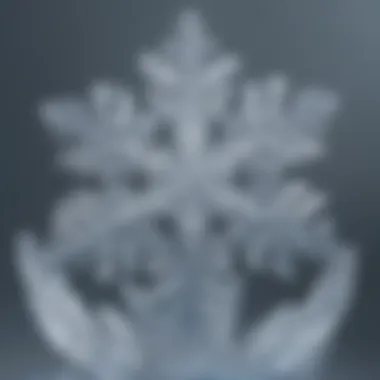Unveiling the Enigmatic Artistry of Crystal Formation with the Snowflake Experiment


Science Fun Facts
Have you ever wondered why snowflakes have such intricate patterns? The answer lies in the complexities of crystal formation. Each snowflake is a unique work of art, shaped by the temperature and humidity in the atmosphere. Even though two snowflakes may look similar, they are never exactly the same, making them truly remarkable creations of nature.
Winter may bring chilly temperatures, but it also brings the magical phenomenon of snowflake formation. As water vapor in the air freezes around tiny dust particles, it begins to take on intricate shapes, resulting in the delicate and beautiful snowflakes we see falling from the sky.
Seeing a snowflake up close reveals its hexagonal structure, with branches extending outwards symmetrically. These breathtaking designs are not just visually appealing but also serve a purpose in assisting scientists in understanding crystal growth and structure at a microscopic level.
Discover the Wonders of Science
Now, let's delve deeper into the science behind the snowflake experiment. By exploring the principles of crystal formation, we can unravel the mysteries of how these stunning ice crystals are formed and appreciate the scientific complexity behind their seemingly simple appearance.
To better comprehend the intricate world of crystal formation, educational videos and animations can help visualize the process in action. Witness the tiny water molecules arrange themselves into intricate patterns, highlighting the beauty of symmetry in nature.
Moreover, interactive learning tools can provide a hands-on experience in exploring the real-life applications of crystallography and snowflake formation. Dive into the world of STEM (Science, Technology, Engineering, and Mathematics) with engaging activities that showcase the relevance of crystallography in various industries and scientific fields.
Science Quiz Time
Are you ready to test your knowledge on crystal formation and the mesmerizing world of snowflakes? Interactive quizzes and brain teasers await to challenge your understanding of the scientific principles behind these intricate ice formations.
Multiple-choice questions will prompt you to think critically about the processes that govern crystal growth and the factors that influence the unique shapes of snowflakes. Dive into the world of science gamification and unleash your problem-solving skills in a fun and engaging quiz session.
Science Experiment Showcase
Get ready to embark on your very own snowflake experiment! This hands-on activity will guide you through the steps of creating your own unique snowflakes and observing the fascinating process of crystal growth firsthand.
With a materials list at your disposal and safety tips to ensure a seamless experiment, you'll learn valuable insights into the principles of chemistry and physics that govern crystal formation. Follow the step-by-step instructions carefully, and watch as water molecules transform into exquisite ice crystals before your eyes.
Introduction
The topic of crystal formation, particularly through the perspective of the snowflake experiment, serves as a captivating entry point into the scientific exploration of how snowflakes, these intricate ice formations, come to be. By delving into the various stages and complexities involved in the creation of snowflakes, readers are set to uncover the mesmerizing beauty and intricate patterns that characterize these natural wonders. This article aims to offer a detailed guide into the fascinating journey of crystal formation, shedding light on the scientific marvels and artistic allure of snowflakes.
The Beauty of Snowflakes
Intricate Patterns
When we observe snowflakes, we are immediately drawn to the mesmerizing intricacy of their patterns. Each snowflake carries a unique design, showcasing the remarkable symmetry and delicate structures that emerge during its formation process. These intricate patterns not only captivate our eyes but also serve as a testament to the exquisite beauty found in nature's creations. Appreciating the delicate balance of these patterns enhances our understanding of the complexity and elegance inherent in snowflake formation, making it a compelling subject for exploration within this article.
Unique Structures
The unique structures of snowflakes add to their enchanting allure. Each snowflake boasts a one-of-a-kind formation, with intricate branches and facets that showcase the inherent beauty of crystal growth. These distinctive structures not only make snowflakes visually stunning but also underline the intricate processes at play during their formation. Understanding the unique structures of snowflakes allows us to appreciate the complexity and diversity found in nature, enriching our exploration of crystal formation within this article.
Natural Phenomenon
Snowflakes represent a captivating natural phenomenon that continues to mystify and astonish observers worldwide. The intricate symmetry and mesmerizing formations found in snowflakes highlight the elegance of natural processes, inviting us to marvel at the wonders of our environment. As a natural phenomenon, snowflakes embody the perfect fusion of artistry and science, serving as a profound source of inspiration and exploration within this article.
Importance of Understanding Crystal Formation
Scientific Significance
The scientific significance of understanding crystal formation lies in its ability to unravel the mysteries of nature's design and intricacy. By studying the process of crystal growth, scientists gain valuable insights into the fundamental principles governing molecular arrangements and structural formations. This scientific significance not only broadens our comprehension of natural phenomena but also paves the way for innovative discoveries and technological advancements, positioning crystal formation as a vital area of scientific inquiry within this article.
Applications in Various Fields
The applications of crystal formation extend far beyond scientific research, finding utility in a myriad of fields such as materials science, chemistry, and engineering. The unique properties and structures of crystals make them indispensable in various industrial processes, from semiconductor technology to pharmaceutical development. Exploring the diverse applications of crystal formation underscores its relevance in driving innovation and progress across different disciplines, highlighting its multidimensional impact within this article.
Educational Value
The educational value inherent in studying crystal formation lies in its ability to offer hands-on learning experiences that foster scientific curiosity and exploration. Through experiments like the snowflake experiment, individuals can engage with the intricacies of crystal growth, gaining practical insights into the formation processes at play. This hands-on approach not only enhances educational outcomes but also instills a sense of wonder and discovery, making crystal formation a valuable educational tool for learners of all ages within this article.


Purpose of the Experiment
Exploring Crystal Growth
One of the primary objectives of the snowflake experiment is to explore the nuances of crystal growth and formation firsthand. By creating a conducive environment for crystal development, participants can witness the gradual emergence of intricate structures and patterns, gaining a deeper understanding of the underlying processes. This hands-on exploration of crystal growth facilitates scientific inquiry and discovery, allowing individuals to observe natural phenomena in action and appreciate the beauty of crystal formation within this article.
Observing Formation Process
The snowflake experiment offers a unique opportunity to observe the formation process of crystals in real time, unveiling the stages of nucleation, growth, and branching that culminate in the creation of snowflakes. By carefully monitoring these processes, participants can witness the intricate transformations that take place at a molecular level, unravelling the mysteries of crystal formation. Observing the formation process not only enriches scientific knowledge but also provides a visually compelling experience that highlights the elegance and complexity of crystal growth within this article.
Hands-On Learning
Hands-on learning forms a core aspect of the snowflake experiment, enabling participants to actively engage with the process of crystal formation and growth. By immersing oneself in the experimental setup and procedures, individuals gain practical insights into the scientific principles governing crystal formation, promoting experiential learning and discovery. This hands-on approach fosters a deeper appreciation for the scientific method and encourages ongoing exploration, making it a valuable educational tool for fostering curiosity and inquiry within this article.
Setting Up the Experiment
In the expedition of delving into the mysterious realm of crystal formation in this elaborate discourse, the section on Setting Up the Experiment stands as a crucial cornerstone. Here, we meticulously prepare the stage for the forthcoming scientific exploration, ensuring precision and adherence to defined protocols. This segment not only lays the foundation for our in-depth investigation but also serves as the gateway to unraveling the complexities shrouding crystal growth. Emphasizing the significance of methodical preparation broaches a deeper understanding of the intricate processes awaiting our scrutiny.
Materials Required
Water
Delving into the properties of water unveils a fundamental element underpinning the entire experiment. Water's unique characteristics play a pivotal role in crystal formation, attributed to its molecular structure and inherent properties. Its versatility and ubiquity in scientific experimentation render water an indispensable asset in our endeavor. Additionally, the solvent properties of water contribute significantly to the success of the experiment, facilitating the crystallization process with unparalleled efficiency and consistency.
String
The inclusion of string in our list of materials delves into its specific utility in the experimental setup. Serving as a catalyst for controlling crystal growth patterns, string offers a tangible element for manipulation and observation. Its flexibility and resilience make it an essential component, enabling researchers to direct and influence the crystallization process effectively. Furthermore, the string's inert nature prevents interference with the crystal formation, ensuring accurate and unadulterated results.
Glass Jar
The presence of a glass jar signifies a pivotal instrument in maintaining the experimental environment's integrity. Offering transparency and durability, the glass jar provides a conducive setting for crystal growth observation. Its inert properties prevent contamination and unwanted interactions, fostering a controlled and secure environment for the experiment. Due to its non-reactive nature, the glass jar preserves the sanctity of the process, allowing for unobstructed monitoring and analysis.
Creating the Ideal Conditions
Exploration of the methodology behind creating the ideal conditions delves into the intricate interplay of various factors influencing crystal growth. The meticulous orchestration of temperature, cooling process, and environmental cleanliness sets the stage for controlled and reproducible outcomes. By meticulously controlling these aspects, researchers lay the groundwork for uncovering the subtleties inherent in crystal formation, paving the way for insightful observations and analysis.
Temperature Control
Controlling temperature emerges as a pivotal parameter in dictating the crystallization process's trajectory. By modulating temperature fluctuations within a specified range, scientists ensure the optimal conditions for crystal growth. The judicious management of heat energy directly impacts the formation kinetics, influencing the size, shape, and complexity of the resulting crystal structures. Treading this delicate balance unlocks a realm of possibilities, elucidating the intimate relationship between temperature variations and crystal morphology.
Slow Cooling Process
The deliberate implementation of a slow cooling process encapsulates a strategic approach towards crystal growth manipulation. By gradually reducing the system's temperature, researchers create a conducive environment for controlled nucleation and growth. This gradual cooling strategy fosters the development of well-defined crystal structures, minimizing defects and irregularities. The deliberate pace at which the cooling process unfolds ensures precision and stability, enabling a meticulous examination of crystal evolution at each stage.
Clean Environment
Maintaining a pristine and sterile environment underscores the importance of unadulterated crystal formation conditions. A clean setting free from contaminants or unwanted particles secures the purity and integrity of the experiment. Eliminating external interferences preserves the authenticity of the crystal growth process, ensuring reliable and reproducible outcomes. The sanctity of the environment guarantees the fidelity of observations, allowing researchers to delve deep into the nuances of crystal formation with confidence.
Safety Measures
Addressing safety precautions within the experimental setup underscores a commitment to ensuring the well-being of participants and the integrity of the investigation. By prioritizing guidelines encompassing adult supervision, proper handling of materials, and caution regarding glassware, researchers mitigate potential hazards and create a secure working environment conducive to effective scientific exploration.
Adult Supervision
The inclusion of adult supervision epitomizes a behavioral safety net ensuring the well-being and guidance of participants involved in the experiment. The presence of a knowledgeable overseer promotes adherence to safety protocols and methodology, mitigating risks and offering real-time assistance in case of emergencies. Adult supervision cultivates a culture of responsibility and accountability, fostering a safe and conducive environment for scientific inquiry.
Proper Handling of Materials
The meticulous handling of materials underscores a commitment to precision and caution in executing the experiment. By adhering to proper handling techniques, researchers minimize the risk of accidents and errors, ensuring smooth progression and accurate data acquisition. The attention to detail and care exercised in material manipulation enhance the experimental integrity, guaranteeing valid and reliable results. Proper handling protocols serve as a pillar of safety and efficiency in the research endeavor.


Caution with Glass
Exercising caution with glassware emerges as a fundamental safety measure aimed at preventing accidents and preserving the experimental setup's stability. Glass, while transparent and durable, poses a risk of breakage if handled improperly. By alerting participants to the potential dangers associated with glass containers, researchers emphasize vigilance and mindfulness during experimental procedures. Prioritizing caution with glassware safeguards both individuals and the experiment itself, ensuring a secure and controlled environment for scientific exploration.
Observing Crystal Growth
Observing crystal growth is a pivotal aspect of this article, shedding light on the progression and formation of snowflakes. By examining the development of crystals, individuals can grasp the intricate details and scientific nuances inherent in this natural phenomenon. Understanding crystal growth allows us to appreciate the complexity and artistry of snowflake formation, providing valuable insights into the beauty of geometric structures in nature.
Initial Stages
Nucleation
Delving into the initial stages of crystal growth unveils the concept of nucleation, a fundamental process contributing to the formation of snowflakes. Nucleation denotes the formation of a nucleus onto which the crystalline structure begins to expand. This critical step sets the foundation for further growth, initiating the mesmerizing journey toward fully developed snowflakes. The unique characteristic of nucleation lies in its ability to define the structure and symmetry of the ensuing crystal, influencing the ultimate design and intricacy of the snowflake.
Crystal Formation Begins
The inception of crystal formation signifies the commencement of the snowflake's intricate growth. As molecules arrange themselves in an orderly manner, the basis of the snowflake's structure emerges. This phase sets the groundwork for the distinct patterns and symmetry characteristic of snowflakes. The significance of this stage lies in its role in dictating the overall shape and design of the crystal, making it a vital component of the observational process for understanding crystal formation in-depth.
Transparent Structure
The transparency of the crystal structure during the initial stages offers a unique perspective on the evolving snowflake. The see-through quality provides a window into the internal organization of the crystal as it takes shape. Observing this transparent structure not only elucidates the complexities inherent in crystal growth but also enhances the visual appeal of the developing snowflake. Understanding the transparent nature of the crystal structure adds a layer of fascination to the observation, allowing for a comprehensive exploration of the snowflake's formation.
Intermediate Phases
Complexity Increases
Advancing into the intermediate phases, the complexity of the snowflake increases, unveiling intricate details and elaborating on the initial formation. This progression showcases the evolving patterns and structures within the crystal, manifesting a higher level of sophistication in the snowflake's design. The heightened complexity contributes to a deeper appreciation of the crystal's beauty and scientific significance, offering a comprehensive outlook on the growth process.
Distinct Branching Patterns
The emergence of distinct branching patterns marks a crucial phase in the snowflake's development, highlighting the unique design elements that characterize each crystal. These branching patterns diversify the snowflake's structure, creating a visually captivating array of shapes and extensions. Analyzing these distinct branches provides valuable insights into the underlying growth mechanisms, enriching the observation of crystal formation and enhancing the overall understanding of snowflake intricacies.
Growth Continues
Continuing the trajectory of growth, the snowflake expands and matures, signaling a phase of continuous development. The ongoing growth process reinforces the intricate details observed in the crystal, emphasizing the dynamic nature of snowflake formation. As the crystal evolves further, the depth and intricacy of its design become more pronounced, encapsulating the beauty and complexity of natural crystal growth.
Final Results
Fully Developed Snowflake
Upon reaching the final stage, the fully developed snowflake unveils its complete structure, showcasing the culmination of the intricate growth process. The fully formed snowflake exhibits a symphony of geometric shapes and patterns, reflecting the precision and beauty inherent in natural crystal formation. The detailed structure of the fully developed snowflake encapsulates the scientific complexity and artistic magnificence of snowflake design, culminating in a unique and captivating final result.
Intricate Design Revealed
Revealing the intricate design of the fully developed snowflake unveils a tapestry of sophisticated patterns and symmetry, underscoring the meticulous growth and structural organization of the crystal. The intricate design not only mesmerizes observers with its detailed arrangements but also conveys the meticulous nature of crystal formation. Exploring the intricate design of the snowflake deepens the understanding of crystal growth processes, emphasizing the delicate balance between scientific principles and aesthetic appeal.
Artistic Beauty
The artistic beauty of the final snowflake transcends mere scientific observation, striking a chord with its visually appealing composition. The artistic components of the snowflake's design reflect nature's inherent creativity and architectural finesse, captivating observers with its beauty and elegance. Delving into the artistic beauty of the snowflake enhances the appreciation for natural formations, intertwining scientific knowledge with artistic expression and highlighting the enchanting allure of crystal growth.
Analyzing the Findings
Analyzing the findings in the context of crystal formation is a critical aspect of this article. By examining the results of the snowflake experiment, we can unravel valuable insights into the structural characteristics, environmental influences, and comparative analysis of crystal growth. This section serves as a bridge between concrete observations and theoretical frameworks, shedding light on the intricacies of crystal formation.
Structural Characteristics
Hexagonal Symmetry
Hexagonal symmetry is a key feature in crystal formation, manifesting in the orderly arrangement of molecules. This geometric pattern lends stability and uniformity to crystals, contributing to their aesthetically pleasing shapes. The hexagonal symmetry of snowflakes showcases nature's precision in molecular alignment, highlighting the efficiency of this structure in optimizing energy and space utilization.


Branching Configuration
The branching configuration of crystals determines their outward growth pattern, adding a distinctive visual appeal. Snowflakes exhibit intricate branching that reflects environmental conditions during their formation. This branching pattern influences the overall shape and complexity of snowflakes, showcasing the dynamic interplay between temperature gradients and water vapor saturation.
Size Disparities
Size disparates among crystals indicate variations in growth rates and nucleation processes. The diverse sizes of snowflakes demonstrate nuanced differences in their formation contexts, ranging from rapid crystal growth to gradual accretion. These size variations offer valuable insights into the temporal and spatial dynamics of crystal growth, depicting the unique journey each snowflake undergoes during its development.
Environmental Influences
Temperature Effects
Temperature intricacies significantly impact crystal formation, dictating the rate of molecular interactions and the crystalline structure. Fluctuations in temperature result in diverse crystal shapes, underscoring the sensitivity of crystals to thermal conditions. Understanding the temperature effects on crystal growth provides a glimpse into the delicate balance between energy input and crystal lattice stabilization.
Humidity Levels
Humidity levels influence the nucleation and growth of crystals, guiding the process of crystal formation towards specific outcomes. Variations in humidity lead to diverse crystalline structures, illustrating the role of water vapor saturation in shaping crystal morphology. Observing how humidity levels affect crystal growth offers a pathway to unraveling the underlying principles of crystal nucleation and growth.
Impact of Air Quality
The quality of air, including impurities and atmospheric composition, can influence crystal clarity and purity. Pollutants in the air may introduce defects in crystal lattices, affecting crystal transparency and structural integrity. Exploring the impact of air quality on crystal formation unveils the interaction between environmental contaminants and crystalline growth processes.
Comparative Analysis
Different Crystal Types
The categorization of crystals into distinct types allows for comparative analysis of their properties and formation mechanisms. Contrasting different crystal types reveals the diversity in molecular arrangements and bonding configurations, elucidating the role of chemical composition in crystal characteristics. Studying various crystal types broadens our understanding of crystallography and the underlying principles governing crystal symmetry.
Synthetic vs. Natural Crystals
Comparing synthetic and natural crystals elucidates the influence of manufacturing processes on crystal properties. Synthetic crystals often exhibit uniformity and purity compared to their natural counterparts, showcasing the impact of human intervention on crystal growth. Contrasting synthetic and natural crystals provides insights into the differences in growth environments and the resulting crystal structures.
Variations in Growth Patterns
Analyzing variations in crystal growth patterns offers a glimpse into the morphological diversity of crystals under different conditions. The unique growth trajectories of crystals reveal the intricate interplay between environmental factors and crystal nucleation mechanisms. Understanding the variations in growth patterns unveils the adaptability of crystals to external stimuli and the natural forces shaping their development.
Conclusion
In concluding the enthralling expedition of crystal formation through the snowflake experiment, it is imperative to underscore the significance of this venture. Delving deep into the intricacies of crystal growth provides invaluable insights into the natural world around us. By immersing oneself in the delicate process of snowflake creation, a profound appreciation for the meticulous design of nature is cultivated. Moreover, this experiment stimulates scientific curiosity, prompting individuals to ponder the complexities of crystal formation and the underlying principles governing this fascinating phenomenon. Educational value is also recognized, as participants not only witness the captivating beauty of snowflakes but also engage in hands-on learning that ignites a passion for scientific exploration.
Key Insights from the Experiment
Appreciation for Nature's Designs
Exploring the meticulous symmetry and intricate patterns of snowflakes instills a deep sense of wonder and awe towards nature's artistry. The flawless hexagonal shapes and unique branching configurations exemplify the sheer brilliance of natural design. Such an exploration not only fosters admiration for the beauty of snowflakes but also nurtures an understanding of the precision and complexity inherent in natural processes.
Scientific Curiosity Stimulated
The snowflake experiment kindles a sense of scientific curiosity by unveiling the secrets behind crystal formation. Observing the transformation of water molecules into stunning ice structures stimulates an inquisitive mind to ask questions and seek answers. This curiosity fuels a quest for knowledge, pushing individuals to explore further and unravel the mysteries of crystal growth.
Educational Value Recognized
Recognizing the educational value of the snowflake experiment lies in its ability to merge theory with practice. Participants not only grasp theoretical concepts of crystal formation but also witness these principles manifest in real-time through the growth of snowflakes. This hands-on approach to learning fosters a deeper retention of knowledge and cultivates a sense of wonder and discovery among learners.
Future Exploration
Further Experiments
Embarking on further experiments in crystal growth opens doors to unlocking new insights and discoveries. By tinkering with various factors influencing crystal formation, individuals can delve deeper into the nuances of this process and potentially uncover novel aspects of crystallography. Experimenting with different conditions and materials propels scientific exploration to new heights, paving the way for enhanced understanding and innovation.
Advanced Crystal Growth Studies
Delving into advanced studies of crystal growth offers a glimpse into the intricate mechanisms governing the formation of diverse crystal structures. By venturing beyond basic experiments and diving into the realm of crystallography, researchers can unravel complex patterns and behaviors exhibited by crystals under specific conditions. Advanced studies provide a comprehensive view of crystal growth, shedding light on the underlying forces shaping these mesmerizing formations.
Interdisciplinary Applications
Exploring the interdisciplinary applications of crystal growth bridges various fields of study, showcasing the ubiquitous nature of crystals in science and technology. From geology to materials science, crystals play a pivotal role in a myriad of disciplines, offering profound insights and applications. By delving into the interdisciplinary facets of crystal growth, researchers can harness the versatile properties of crystals to drive innovation and advancements across different domains.







